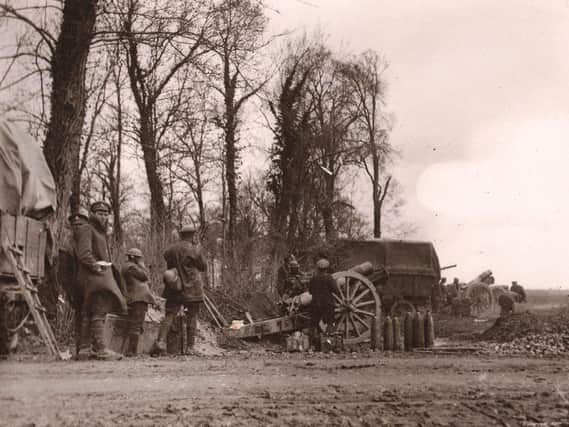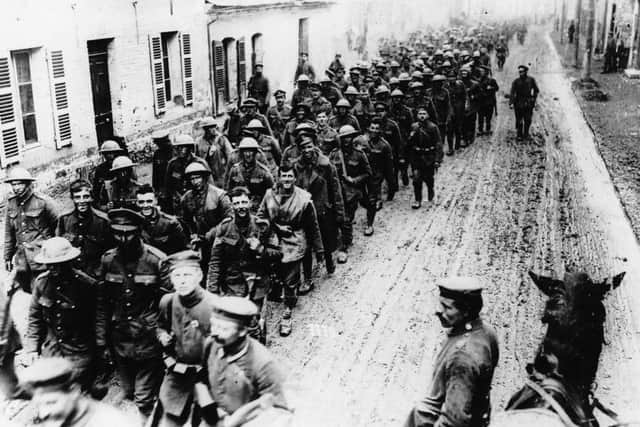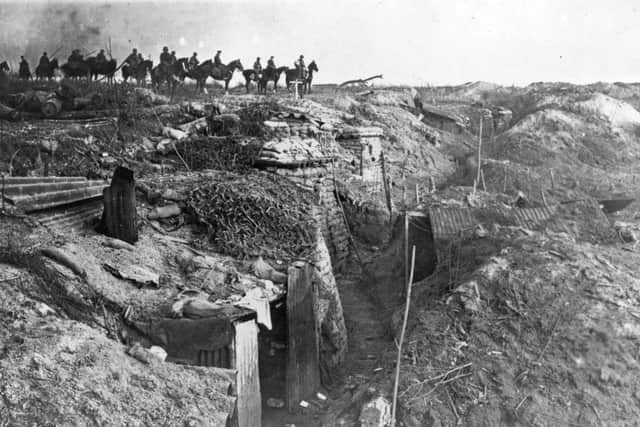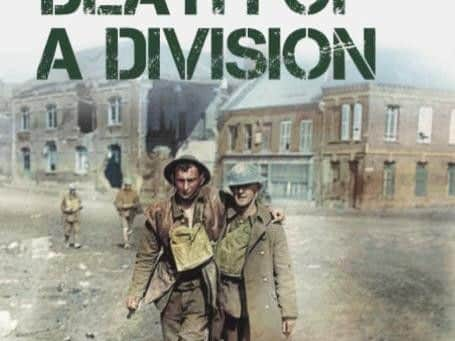How brave soldiers paid the price for a most brutal victory


It was imperative to bring all the Allies’ defensive might to bear on the Western Front, as the offensive would probably fall on the open chalk downlands between Arras and St Quentin.
It was here that the 30th Division, from Manchester and Liverpool, and 66th Division, from East Lancashire, were both placed 10 miles apart, facing the German onslaught in 1918.
Advertisement
Hide AdAdvertisement
Hide AdThe men of the 66th Division was made up of the territorial units of the Lancashire Fusiliers, the East Lancashire Regiment and the Manchester Regiment and were mostly ordinary mill workers, colliers, railwaymen and clerks from the mill towns of Lancashire. Their bravery over eight days of battle was to help turn the tide of the First World War.


Building new lines of defence in winter was impracticable. The forward line had existed for a year but now all effort was put into the redoubt line that would be so important in the battle ahead, and the Green line was barely started.
To make matters worse, a thick fog descended on the battlefield on the night of March 20.
Gunner John Gore, in Hervilly, on the Green line, was not enjoying his surroundings, and wrote in his diary on March 16: “Getting used to these cramped quarters.
Advertisement
Hide AdAdvertisement
Hide AdWe have been re-equipped from Quartermasters stores and plenty of clothes and boots. There is an ominous feeling about, as if something is going to happen,” and on March 20, “got the wind up, slept with clothes on.”


At 4.30 the next morning, as Lance Corporal William Sharpe recalled, “A terrific bombardment started – a succession of falling shells dropping increasingly near with each successive round.
We who had been at Ypres began to compare, saying it was as bad, but it continued to get worse and came to a pitch when it seemed impossible that anything could live in it, and personally I prayed with every reverence.”
Colonel Wilfrith Elstob was in command of the 16/ Manchesters of the 30th Division, near St Quentin, at the Manchester Hill redoubt.
Advertisement
Hide AdAdvertisement
Hide AdThe redoubt system had been developed during the winter, a heavily defended area of trenches, offering all round fire and dominating local high ground. These were provisioned with a dump of ammunition, food, lines of wire and dugouts.


Elstob was full of ‘fight’, leading his men with the words: “Here we fight and here we die!” This, like many other redoubts, held off all German attacks until the mid afternoon of Thursday, March 21.
Elstob’s valiant defence won him the posthumous award of the Victoria Cross.
Ten miles to the north, the territorials of the 66th (East Lancashire) division were at Hargicourt.
Advertisement
Hide AdAdvertisement
Hide AdThe trenches on the Cologne Ridge were packed with Lancashire soldiers who had to undergo the four hour bombardment in gas masks.


They then faced the German infantry attack which was aided by the thick fog. Frontline soldiers were killed or taken prisoner.
A soldier in the second line, Ralph Frost, was marching up to the battle line; “I should think we marched about three miles, when out of the mist five men of the 2/5 Manchester were seen coming towards us shouting – ‘Don’t shoot, we are British, Jerry has taken our front line and we are the only survivors’.”
Elsewhere along the divisional front: “A large group of stragglers, composed of all units, were now seen making their way up the valley. These were collected, divided into sections and allotted various sectors of defence.”
Advertisement
Hide AdAdvertisement
Hide AdThese were the remnants of the frontline battalions. For many thousands of men, captivity was inevitable and, whatever that might bring, many were just glad to be out of it.
Lance Corporal Sharpe was among those caught: “A few of the lads bolted up the edge of the road and the remainder of us stood still, simply amazed, and were again fired at by a German officer.
Directly afterwards a shell burst (one of ours we presumed) just a few yards away and I am sure this saved our lives. We were then told to put up our hands and of course, there was no help for it, for the whole road was occupied by Germans.”


In the redoubt line British soldiers held out well into the afternoon.
Advertisement
Hide AdAdvertisement
Hide AdOften they surrendered when the sound of battle was obviously far to the west. Others followed suit when their officers were killed.
Most of the redoubts in the 66th Division area were unfinished and such was the determination of the German attacks that they soon ran out of ammunition.
For 66th Division the front performed a slow cave-in as their flanks were turned. Around midday, counter attacks were made by infantry, tanks and dismounted cavalry.
Some achieved success, but the redoubts which carried on fighting were soon bypassed by the flood of enemy soldiers.
Advertisement
Hide AdAdvertisement
Hide AdThe actions of the 21-year-old Captain Hopkins were typical: “With wonderful courage he insisted on carrying on, controlling, directing fire and urging the men like the splendid soldier he showed himself to be.
At last, when not a single man remained of his party, he himself took a Lewis gun. I was then by his side, getting the other gun into action, and saw what happened.
A bullet struck the gun he was firing and hit him in the lower part of the face. As he sank back he said to me ‘Fire the gun Mr Johnston – fire the gun’.”
The medics at Templeux Advanced Dressing Station were overwhelmed with casualties and had to look after them in the storm of battle.
Advertisement
Hide AdAdvertisement
Hide AdSergeant Alfred Francis recalled it was time to leave: “The work of loading up the wagons with medical stores and equipment was done in a time never previously approached on parade ground practices.
“As the medics fled one side of the Dressing Station, the Germans were on the other side, and captured eight men.”
On March 22, General Gough, of Fifth Army, ordered a bridgehead to be held around the town of Péronne as the remnants of a shattered army retreated over the Somme.
The defence would have been based on the much vaunted Green Line, which was found to be totally insufficient. A smaller perimeter closer to the river was held while troops fell back on the River Somme.
Advertisement
Hide AdAdvertisement
Hide AdThe engineer officers soon found that blowing a girder bridge does not entirely remove it, and enemy infantry were often still able to cross ‘destroyed’ bridges.
Hubert Gough was sacked soon after for not holding the river line and not sacrificing his divisions.
Buoyed on by their success the German High Command changed their initial plan of moving north and decided to cross the river and head for Amiens.
The German soldiers were also tired and took out their feelings on the town of Péronne. They spent the Saturday night ransacking the town as Manchester soldier Peter Hall recalled: “I shall never forget that night. In spite of the efforts of the French to get rid of the wine, the German advance had been so rapid that they had not been able to destroy all their stocks completely and the Germans were soon roaringly drunk, singing and shouting, and by midnight setting fire to buildings all over the town.”
Advertisement
Hide AdAdvertisement
Hide AdGerman forces pressed their attack to the north of the Somme river and across it against the depleted British forces. The line held for a while, and the Germans got ahead of the British on the north bank of the river, sending an infantry pincer behind the British line at Warfusée – Abancourt.
Allied commanders were stretched by the general situation and forced to unite under French command on March 26. The 66th Division was almost surrounded but was able to retreat to the south west. Had this pincer been more successful the Germans might have won the battle, however, disaster was avoided as fresh reserves under Colonel Little and Major Kingham arrived and the British fell back on Villers-Bretonneux, where much needed Australian forces were digging in.
It was soon apparent to both Allied and German commanders the German offensive had failed, and the war would be won by the Allies, even though it would take eight months to achieve it.
The Commander of 66th Division, General Malcolm, declared on March 27, “Gentlemen, we have won the war!”
Advertisement
Hide AdAdvertisement
Hide AdIt was a close call and even brigadiers and generals were forced to fight in the trenches as so few men were left.
In the trenches near Amiens a few tired survivors of the British Divisions still held out. The two Lancashire Divisions, the 30th and 66th, were among those taking the brunt of the fighting, and were shattered, with 5,000 and 7,000 casualties apiece.
The 42nd Division, from East Lancashire, was brought into the fight on March 24 and sustained 2,000 casualties, whilst the 57th Division, from West Lancashire, was soon fighting near Estaires against a further German attack.
This turned out to be a decisive month of battle and German attempts to take Villers-Bretonneux would fail against British and Australian forces.
Advertisement
Hide AdAdvertisement
Hide AdThe first tank versus tank battle was fought at Villers-Bretonneux on April 24 but proved to be inconclusive. New weapons were changing the face of battle, including the Whippet tank. American forces were soon landing in France in overwhelming numbers and would be trained by the survivors of the offensive so that by the summer the US could take an active fighting role.
Lancashire soldiers had paid the price and fought valiantly in the battle, somehow wresting victory from defeat.
l Death of a Division Eight Days in March 1918 and the Untold Story of the 66th (2/1st East Lancashire) Division by David Martin is available priced from £19.99 Pen & Sword.
A book launch will be held at Lancashire Infantry Museum at Fulwood Barracks, Preston, 11am to 3pm, on April 14 with a chance to meet and talk to the author. To book a place contact the author on [email protected]. Photo ID is essential on the day.